 The Columbia City Yoga on-line Moving into Meditation class met this morning. We continued the practice of building beloved community by exploring the pain of bias. We used our imagination as an ally to help look beneath the surface of others. We cultivated empathy and offered loving kindness to ourselves and others. This is something we can practice informally as we go about our day. We can slow down, pause and imagine the wholeness of a person we may see behind the wheel, mowing their lawn, shopping for groceries. We can wish them well.
The Columbia City Yoga on-line Moving into Meditation class met this morning. We continued the practice of building beloved community by exploring the pain of bias. We used our imagination as an ally to help look beneath the surface of others. We cultivated empathy and offered loving kindness to ourselves and others. This is something we can practice informally as we go about our day. We can slow down, pause and imagine the wholeness of a person we may see behind the wheel, mowing their lawn, shopping for groceries. We can wish them well.
We practiced mindfulness and explored Anu Gupta’s loving kindness practice around the pain of bias. This practice engages imagination to call people who have experienced the pain of bias into our hearts. We visualize and sense their presence and the goodwill and love we share for one another. In this way our individual separate practice becomes relational in a sense. We cultivate prosocial qualities that can incline our minds toward beloved community.
 We drew insight from Zen teacher and poet Norman Fischer. His fascinating Tricycle Magazine article, Saved from Freezing, is an exploration of how our imagination can be our ally in experiencing life beyond the limitations of the beliefs, ideas, assumptions, even worries.
We drew insight from Zen teacher and poet Norman Fischer. His fascinating Tricycle Magazine article, Saved from Freezing, is an exploration of how our imagination can be our ally in experiencing life beyond the limitations of the beliefs, ideas, assumptions, even worries.
He gives examples of how music and poetry can transport us to a “different mind” that is more open to life.
Guided Reflection
This week I noticed myself making assumptions about others and then interrupting that habit just to acknowledge: “I don’t know.” And to consider: “Where do these assumptions come from?” I stumbled on a wonderful article about imagination, art and spirituality by Zen teacher and poet Norman Fischer. He starts by writing:
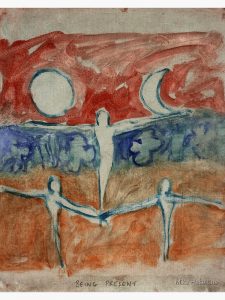 Spiritual practice requires imagination. If we really want to go beyond the surface of things to the deeply hidden, actual experience of being alive, we need imagination as an ally. The senses, reason, even our moral and emotional faculties are not enough.
Spiritual practice requires imagination. If we really want to go beyond the surface of things to the deeply hidden, actual experience of being alive, we need imagination as an ally. The senses, reason, even our moral and emotional faculties are not enough.
I love the idea of having imagination as my ally. Norman describes driving around in his car listening to the news and tending to the busyness of his day. He tuned in to a Beethoven sonata. He describes a change in mind:
Listening to the music, my mind gradually starts to release, like a hand that had been grasping something tightly and is beginning to let go. Another mind appears, a mind completely engaged with the pattern the music weaves. A moment before, I’d been frozen into the shape of a self in a world. Now, the music has thawed me out.
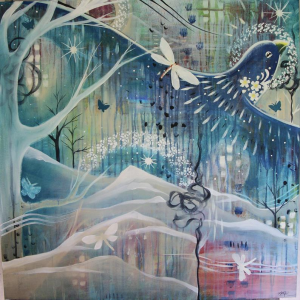 He goes on to explore how the world and the self are built by structures that seem to hold things in place: ideas, beliefs, worries. He believes art and spirituality can free us from being limited to these structures. We get a much larger view of our lives and the world. He cautions about how spiritual practice can also be practiced to build structures:
He goes on to explore how the world and the self are built by structures that seem to hold things in place: ideas, beliefs, worries. He believes art and spirituality can free us from being limited to these structures. We get a much larger view of our lives and the world. He cautions about how spiritual practice can also be practiced to build structures:
We crave a secure sense of self, a truth we can depend on, a world we can tame and understand. We want to be frozen, even as we long desperately to thaw. Religion is problematic because we are problematic.
He describes how imagination can give us access to a reality that is
. . . wider, deeper, and more mysterious than we can directly sense or rationally know. Imagination can see into and through the apparent world to something luminous and significant.
I would add that imagination is our ally in helping us to cultivate empathy for others who are different than we are. Our mindfulness practice is a form of prosocial behavior that helps us to incline our minds toward loving kindness, compassion, gratitude, equanimity, generosity, joy and forgiveness. Today I want to return to the practice of loving kindness. We can use our imagination to help us feel more connected to others. As many of you know, loving kindness is a state of unconditional friendliness toward all beings. Anu Gupta reminds us that:
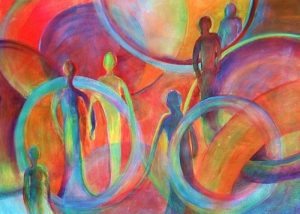 Our ability to incline our heart minds to these positive states is what teachers like Thich Nhat Hanh and Dr. Martin Luther King have described as being part of a beloved community.
Our ability to incline our heart minds to these positive states is what teachers like Thich Nhat Hanh and Dr. Martin Luther King have described as being part of a beloved community.
So let’s begin our loving kindness practice together. Please adjust your posture so that you can be at ease and mindful. Bring your eyes to a close or a stationery point in front of you. You might want to stretch. Take a few deep breaths and let them go. Gradually allow your awareness to rest with the breath or an area of neutral sensation in the body. Can you feel the healing, nourishing stream of each inhale, each exhale? If you like, you can slowly scan your body beginning with the soft tissue across your brow and around your eyes. Moving along your jaw and the little muscles around your mouth. Sense the softness of your lips. The hard and soft areas along your neck and around your throat. Feel the orientation of your upper back and shoulders. Slowly travel down your arms to your hands. Are the arms and hands relaxed? Sense the areas over your chest and belly. Do they move with each breath? You might feel the weight of your lower body, your low back and pelvis. Moving around hips, down thighs, legs into the feet. Are your legs and feet resting easy? Can you relax whatever you can in your whole body? If possible, find a sense of ease, openness and spaciousness.
 As you’re ready bring to mind a person you love who has experienced the pain of bias. Perhaps it’s a family member, a friend, a colleague, a teacher. See this person in the window of your mind. Notice their goodness, their innocence. As you feel your love for them you might also sense their deep concern and love for you. See this person you love smiling at you and smile back at them. See if you can offer them these well wishes you can silently in your mind: “May you be happy. May you be healthy. May you be safe. May you live with ease.” You can repeat these phrases for your beloved being at your own pace a few more times. As you repeat these phrases, can you see this beloved being receive these words and well wishes from you? Sense how they appreciate you for holding them in loving kindness.
As you’re ready bring to mind a person you love who has experienced the pain of bias. Perhaps it’s a family member, a friend, a colleague, a teacher. See this person in the window of your mind. Notice their goodness, their innocence. As you feel your love for them you might also sense their deep concern and love for you. See this person you love smiling at you and smile back at them. See if you can offer them these well wishes you can silently in your mind: “May you be happy. May you be healthy. May you be safe. May you live with ease.” You can repeat these phrases for your beloved being at your own pace a few more times. As you repeat these phrases, can you see this beloved being receive these words and well wishes from you? Sense how they appreciate you for holding them in loving kindness.
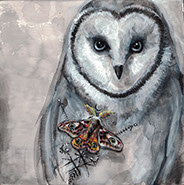 Allow these imaginings to fade from the window of your mind. Now bring to mind someone who is different from you. Someone who has experienced the pain of bias. Perhaps this is someone you know who has a different gender identity, sexual orientation, race or ethnicity or something else. As you imagine this person in the window of your mind, imagine beyond what you see on the outside. Begin to bear witness to the wholeness of this human being that’s present. A human being who has experienced the pain of bias. As you imagine this being’s presence in your mind you can share the same four well wishes: “May you be happy, may you be healthy, may you be safe, may you live with ease.” Repeat these well wishes towards this being a few more times at your own pace. Can you feel the affects that this practice has on your body? Is there an inclination in your mind towards loving kindness, towards unconditional friendliness? Notice this being receiving these well wishes from you. Sense how they appreciate you holding them in loving kindness.
Allow these imaginings to fade from the window of your mind. Now bring to mind someone who is different from you. Someone who has experienced the pain of bias. Perhaps this is someone you know who has a different gender identity, sexual orientation, race or ethnicity or something else. As you imagine this person in the window of your mind, imagine beyond what you see on the outside. Begin to bear witness to the wholeness of this human being that’s present. A human being who has experienced the pain of bias. As you imagine this being’s presence in your mind you can share the same four well wishes: “May you be happy, may you be healthy, may you be safe, may you live with ease.” Repeat these well wishes towards this being a few more times at your own pace. Can you feel the affects that this practice has on your body? Is there an inclination in your mind towards loving kindness, towards unconditional friendliness? Notice this being receiving these well wishes from you. Sense how they appreciate you holding them in loving kindness.
Allow these imaginings to fade from the window of your mind. Bring to mind an image of yourself. Imagine seeing yourself as you are now or as a younger person. A person who has also experienced the pain of bias. Take a moment to connect with this experience if you can. Let it be easy, without struggle. If you don’t connect with the experience, connect with yourself just as you are. Offer these well wishes to yourself. Repeat these phrases towards yourself a few more times. Notice how it feels to receive your own loving kindness.
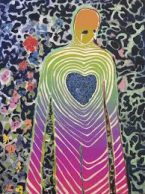 As we near a close you might set an intention to practice loving kindness for yourself and others. Sometimes it’s difficult to send well wishes to yourself. Try to find phrases or simple practices that feel authentic. You might pause, put a hand on your heart and say “It’s o.k. to feel this.” You can share the well wishes with anyone at any time. While walking around, while driving, in the grocery store.
As we near a close you might set an intention to practice loving kindness for yourself and others. Sometimes it’s difficult to send well wishes to yourself. Try to find phrases or simple practices that feel authentic. You might pause, put a hand on your heart and say “It’s o.k. to feel this.” You can share the well wishes with anyone at any time. While walking around, while driving, in the grocery store.
As Norman says we can use our imagination to “go beyond the surface of things to the deeply hidden.” “Imagination can see into and through the apparent world to something luminous and significant.” Together we can incline our minds toward understanding, loving kindness and beloved community.
